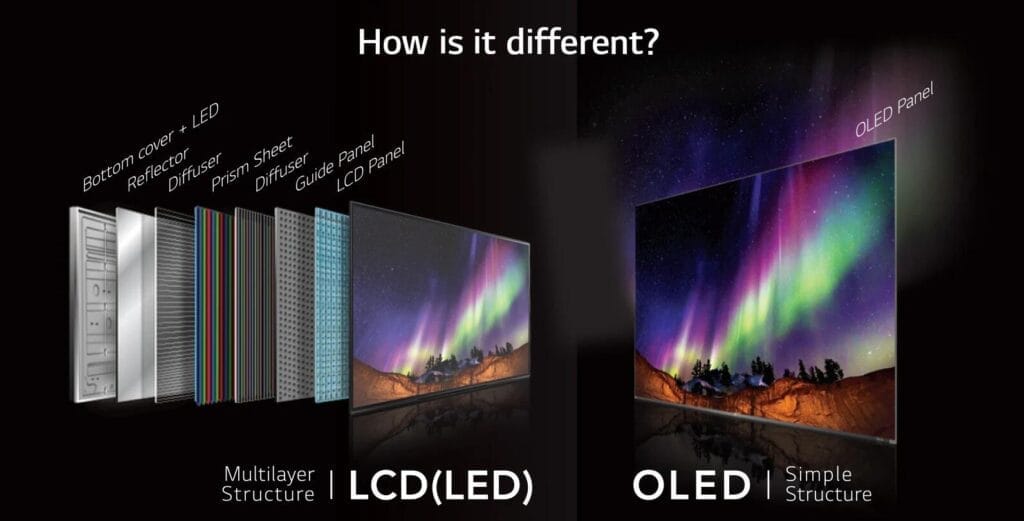
In our digital-first world, the type of monitor you choose can significantly affect your experience, whether you’re gaming, designing, or simply browsing the web. The debate between OLED (Organic Light Emitting Diode) and LCD (Liquid Crystal Display) monitors is pivotal for many users. This guide will thoroughly explore these technologies, comparing their features, benefits, and drawbacks while considering the specific needs of various users. Additionally, we’ll highlight the exceptional benefits of ONext’s OLED portable monitors.
Understanding Display Technologies
What is an OLED Monitor?
OLED portable monitors utilize organic compounds that emit light when an electric current is applied. This design allows each pixel to illuminate independently, enabling true black levels and stunning contrast. When a pixel is turned off, it emits no light, producing perfect blacks and vibrant colors. This capability translates into exceptional image quality that captivates viewers, making OLED monitors particularly popular among gamers, movie enthusiasts, and professionals in creative fields.
What is an LCD Monitor?
LCD monitors, on the other hand, rely on a backlight to illuminate the liquid crystals that form the display. This backlight is essential for producing images, which means that even the darkest colors can never truly reach black; they may appear as shades of gray. While LCD technology has improved significantly, particularly with the advent of IPS (In-Plane Switching) panels, it still lacks the contrast and color vibrancy of OLED.
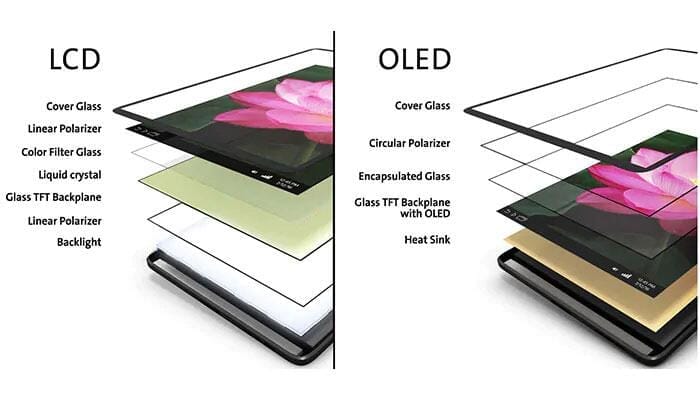
Key Comparisons: Image Quality, Color, and Contrast
Image Quality
OLED Monitors: The image quality of OLED portable monitors is often hailed as the best in the industry. The ability to achieve true black levels results in high contrast ratios and dynamic range, which is particularly beneficial for content that features dark scenes or requires precise color detail. The colors appear more vivid, making for a more engaging viewing experience.
LCD Monitors: While LCDs provide decent image quality, they typically can’t match the deep blacks and bright highlights of OLED displays. The reliance on backlighting often leads to light bleed, particularly in dark scenes, where the contrast can suffer. This can detract from the immersive experience that many users seek, especially when watching movies or playing games.

Color Accuracy and Saturation
OLED Monitors: One of the standout features of OLED technology is its wide color gamut. This allows OLED monitors to reproduce a broader range of colors with greater accuracy and saturation. For professionals involved in graphic design, photography, or video editing, this means more realistic and true-to-life visuals. The vibrant colors of an OLED monitor can bring images to life in ways that LCDs often cannot.
LCD Monitors: While advancements in LCD technology have led to improved color reproduction, they still tend to be less vibrant compared to OLEDs. Colors can appear more muted, and although high-quality LCD panels can offer good accuracy, they may not have the same level of detail or richness. For users who prioritize natural color representation over vibrancy, LCDs may still be a viable choice.
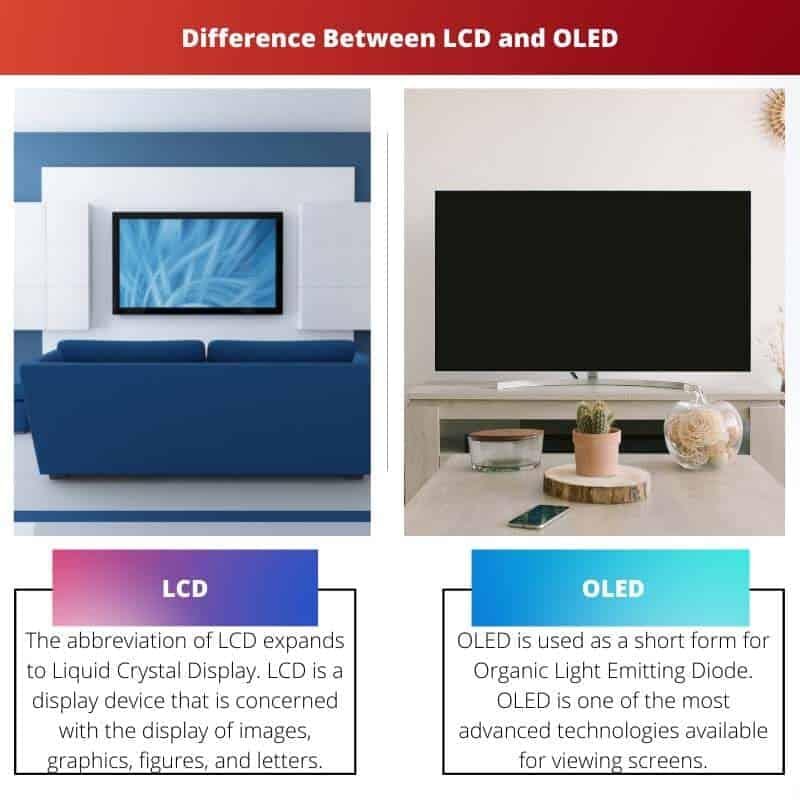
Viewing Angles
OLED Monitors: One of the significant advantages of OLED portable monitors is their superior viewing angles. Because each pixel emits its own light, image quality remains consistent even when viewed from an angle. This feature is particularly beneficial in collaborative settings, where multiple viewers may be watching the same screen.
LCD Monitors: In contrast, LCD monitors can suffer from color and contrast shifts when viewed from angles. Depending on the type of panel, users may notice that colors look washed out or that the image loses clarity when not viewed head-on. This can limit the usability of LCD monitors in group settings, where everyone may not be directly in front of the screen.
Contrast
OLED Monitors: The infinite contrast ratio of OLED monitors is one of their most significant selling points. By turning off individual pixels, OLED displays achieve true black levels, which enhances the overall depth and detail in images. This capability is particularly evident in dark scenes, where details that might be lost on an LCD can be seen clearly.
LCD Monitors: Although LCDs have improved in contrast over the years, they are still limited by their backlighting. As a result, black levels can appear grayish, especially in lower-quality models. This limitation can diminish the overall viewing experience, particularly for users who enjoy cinematic content.
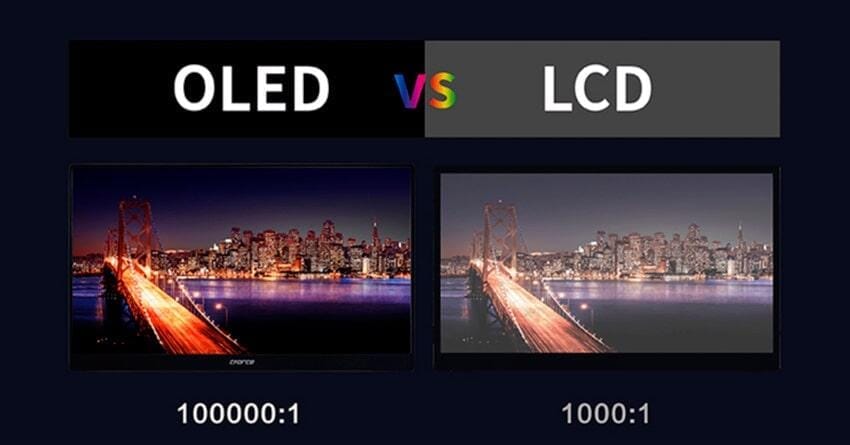
Lifespan and Energy Efficiency
Lifespan
OLED Portable Monitors: One of the drawbacks of OLED technology is its potential for burn-in. When static images are displayed for extended periods, they can leave a permanent mark on the screen. This phenomenon occurs because the organic compounds used in OLEDs can degrade unevenly, especially the blue subpixels. While manufacturers have implemented various solutions to mitigate this issue, it remains a concern for users who frequently display static content, such as news tickers or game HUDs.
LCD Monitors: In comparison, LCD monitors generally have a longer lifespan and are not prone to burn-in. They can handle static images without significant degradation over time, making them more suitable for users who often work with fixed content, such as spreadsheets or presentations. For everyday tasks, LCDs provide a reliable option without the worry of image retention.
Energy Efficiency
OLED Portable Monitors: OLED portable monitors can be more energy-efficient when displaying darker images, as they only power the pixels that are actively used. This can lead to lower power consumption for darker content, making OLEDs an attractive choice for users who frequently work with multimedia.
LCD Monitors: LCDs maintain a more consistent power consumption regardless of the displayed content. In scenarios where bright or white screens are prevalent, this can lead to higher energy usage. For users concerned about energy efficiency, the type of content displayed may influence their choice between OLED and LCD.
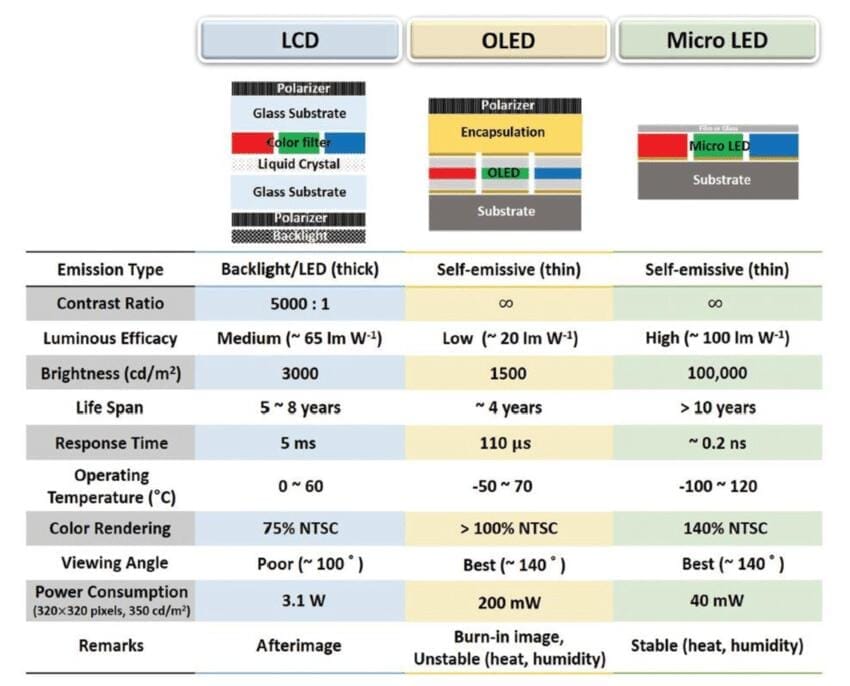
Cost Considerations
Price of Quality: OLED
Typically, OLED portable monitors come with a higher price point due to the complexity of their manufacturing process and the advanced technology they incorporate. The investment, however, is often justified by the exceptional quality, performance, and immersive viewing experience they offer. For professionals in creative fields, the enhanced color accuracy and image quality can significantly impact their work.
Budget-Friendly LCD Options
LCD monitors are usually more affordable and come in a wide range of options to suit different budgets. For everyday tasks such as web browsing, office work, and casual gaming, LCDs can provide satisfactory performance without a substantial financial investment. This affordability makes them an appealing choice for casual users who may not require the advanced features of OLED technology.
User Needs: Who Should Choose OLED vs. LCD?
Understanding the specific needs of different user types can help clarify the ideal monitor choice. Here’s a detailed comparison of user types and their preferred monitor types:
Comparison Table: User Types and Monitor Recommendations
| User Type | Preferred Monitor Type | Reasons for Choice |
|---|---|---|
| Gamers | OLED Portable Monitor | – True blacks enhance immersion – Faster response times for competitive play – Vibrant colors for dynamic visuals |
| Graphic Designers | OLED Portable Monitor | – Superior color accuracy for editing – Greater detail for high-resolution images – Perfect for color-critical work |
| Office Workers | LCD Monitor | – Generally more affordable – Adequate for spreadsheets and documents – Longer lifespan for static content |
| Content Creators | OLED Portable Monitor | – Excellent color reproduction for video editing – Portability for on-the-go editing – High-quality visuals for presentations |
| Movie Enthusiasts | OLED Portable Monitor | – Stunning contrast for dark scenes – Immersive viewing experience for film watching – Great for home theater setups |
| Casual Users | LCD Monitor | – Cost-effective for browsing and casual gaming – Sufficient quality for everyday tasks – Less risk of burn-in |
| Traveling Professionals | ONext OLED Portable Monitor | – Lightweight and compact design – Exceptional visuals for presentations – Versatile connectivity options |

Experimental Testing: Real-World Use Cases
To further understand the practical differences between OLED and LCD monitors, we can consider hypothetical experimental scenarios that illustrate their performance in various situations:
- Gaming Scenario: A group of gamers tests an OLED portable monitor against an LCD monitor while playing a visually intensive game. Feedback reveals that the OLED monitor provides deeper immersion with true blacks, while the LCD monitor struggles with color depth, especially in dark scenes.
- Design and Editing Scenario: Graphic designers utilize both types of monitors to edit high-resolution images. Designers consistently find that the OLED portable monitor’s color accuracy and brightness allow for more precise edits, while the LCD monitor falls short in reproducing certain colors, leading to less satisfactory results.
- Office Productivity Scenario: Office workers use both monitors for daily tasks over a week. They discover that while the LCD monitor is sufficient for general tasks, they appreciate the vibrancy of the OLED portable monitor when reviewing presentations or visual content, ultimately enhancing productivity.
- Multimedia Experience: Movie enthusiasts watch the same film on both monitor types. Viewers overwhelmingly prefer the OLED portable monitor for its superior contrast and immersive experience during darker scenes, highlighting the advantages of OLED technology for cinematic viewing.
ONext OLED Portable Monitors: The Best of Both Worlds
For those seeking portability without sacrificing quality, ONext’s OLED portable monitors are the ideal solution. These monitors combine the breathtaking quality of OLED with a compact design, making them perfect for professionals on the go, gamers, and content creators alike.
Benefits of ONext OLED Portable Monitors
- Superior Visuals Anywhere: Enjoy stunning image quality and vibrant colors wherever you go.
- Lightweight and Compact: Easy to transport, making them ideal for travel and presentations.
- Exceptional Connectivity: Multiple connectivity options allow seamless switching between devices.
- Ergonomic Design: Adjustable stands ensure comfortable viewing angles.
- Versatility: Suitable for a wide range of users, from gamers to graphic designers.
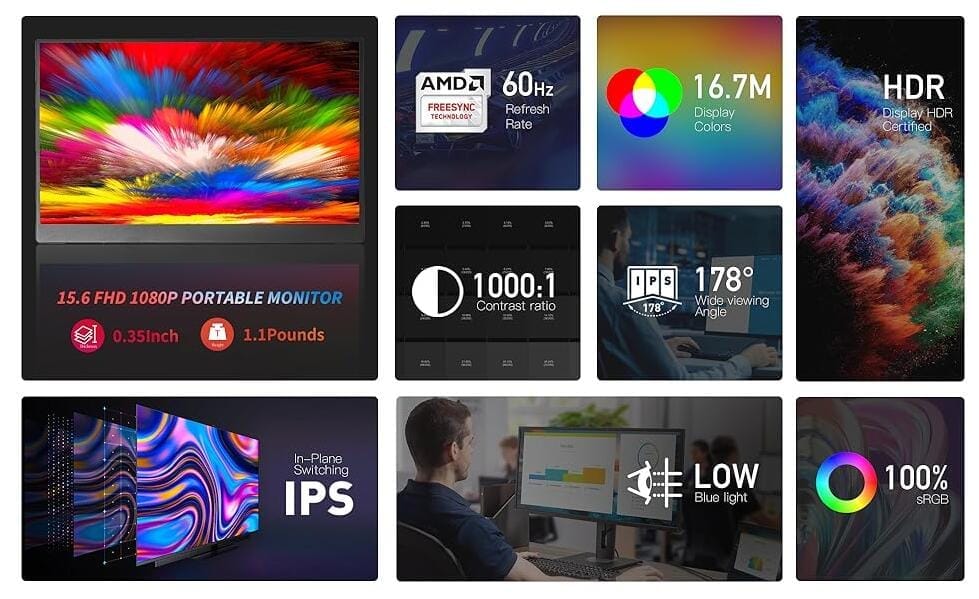
Additional Considerations: Future Trends and Technologies
As technology continues to advance, the landscape of monitor displays is evolving rapidly. Here are some emerging trends and considerations to keep in mind when choosing between OLED and LCD monitors:
Advances in LCD Technology
While OLED technology has gained considerable attention, LCD manufacturers are continually innovating to enhance their products. Technologies like Mini-LED and Micro-LED are pushing the boundaries of what LCDs can achieve. Mini-LED backlighting, for instance, allows for more localized dimming zones, improving contrast and black levels, and bringing them closer to OLED performance. Micro-LED, on the other hand, combines the benefits of OLED and LCD by offering self-emissive pixels similar to OLED, but without the risk of burn-in, making it a promising future option.
OLED’s Growing Popularity
The popularity of OLED displays is on the rise, not just in monitors but also in televisions, smartphones, and other devices. As manufacturing techniques improve and costs decrease, we can expect to see more OLED options at various price points, making this technology accessible to a broader audience. The increased competition may also spur innovations that enhance durability and address concerns such as burn-in.
Sustainability and Energy Efficiency
In a world increasingly focused on sustainability, energy efficiency is becoming a critical factor in purchasing decisions. OLED portable monitors can be more energy-efficient when displaying darker images, but users should consider their typical usage patterns. Conversely, advancements in LCD technology are also making them more energy-efficient. As consumers become more environmentally conscious, opting for monitors that minimize energy consumption and environmental impact will be essential.
Gamers and the Rise of 4K and 8K Displays
The gaming community is driving demand for high-resolution monitors, with 4K and even 8K displays becoming more common. Both OLED and high-end LCDs are now available in these resolutions, offering gamers incredibly detailed visuals. However, gamers should also consider factors such as refresh rates and response times, which are critical for competitive gaming. OLED monitors generally provide faster response times, reducing motion blur, which can be a decisive factor for serious gamers.
Content Creation and HDR
High Dynamic Range (HDR) content is increasingly prevalent in video production and streaming. HDR requires displays that can showcase a broader range of brightness and color. OLED monitors excel in HDR capabilities due to their infinite contrast ratios and vivid color reproduction. For content creators working in HDR, an OLED portable monitor may be the best choice to accurately produce and edit high-quality visuals.

Troubleshooting Common Display Issues
Regardless of the monitor type, users may encounter various issues. Here are some common problems and their solutions:
OLED Monitor Burn-In
Issue: Static images, such as logos or game HUDs, can leave permanent marks on the screen.
Solution: To mitigate burn-in, avoid displaying static images for prolonged periods. Utilize screen savers or pixel-shifting features, if available. Additionally, consider varying your content to prevent static images from lingering too long.
LCD Backlight Bleeding
Issue: Light leaking around the edges of the screen can result in uneven brightness.
Solution: While some degree of backlight bleed is normal, ensure that you’re purchasing from reputable manufacturers who offer good quality control. If severe bleeding occurs, consider returning the monitor for a replacement.
Color Calibration
Issue: Both OLED and LCD monitors may not display colors accurately out of the box.
Solution: For graphic design and photo editing, invest in a color calibration tool to ensure your monitor displays colors correctly. Many high-end monitors come with calibration software, which can help achieve optimal results.
Connectivity Issues
Issue: Difficulty connecting devices can lead to frustration.
Solution: Ensure that your cables are in good condition and that you’re using the correct ports. Check your device settings to confirm that the correct output is selected. If issues persist, consult the monitor’s user manual for troubleshooting tips.
Final Thoughts
In the end, the choice between OLED and LCD monitors hinges on individual preferences and specific use cases. For those who prioritize color accuracy, immersive visuals, and superior viewing angles, OLED portable monitors are undoubtedly worth considering. On the other hand, if you are looking for a reliable, cost-effective option for everyday tasks or are concerned about burn-in, LCD monitors remain a strong choice.
The introduction of ONext OLED portable monitors adds a new dimension to this decision, offering exceptional quality and portability for users on the go. Whether you’re a gamer, a designer, or simply someone who enjoys high-quality visuals, ONext’s portable monitors ensure you don’t have to compromise on performance or convenience.
By weighing the benefits and limitations of each technology and considering your specific needs, you can make an informed decision that will enhance your digital experiences. As monitor technology continues to advance, staying updated on the latest trends and developments will help you choose a display that meets your evolving requirements.
Whether you opt for the stunning visuals of OLED or the practicality of LCD, the right monitor can significantly improve how you work, play, and enjoy content. The key is to find a display that aligns with your lifestyle, preferences, and budget, ensuring that you can enjoy the best of what modern technology has to offer.
ONext’s OLED portable monitors
-
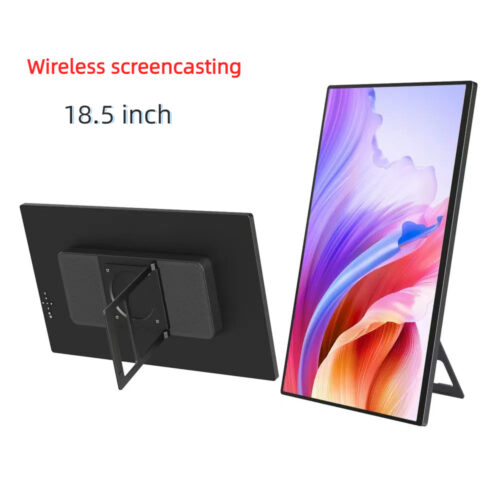 ONext 18.5 inch Portable Laptop Monitor ,Wireless screencasting Laptop Monitors with Kickstand
ONext 18.5 inch Portable Laptop Monitor ,Wireless screencasting Laptop Monitors with Kickstand -
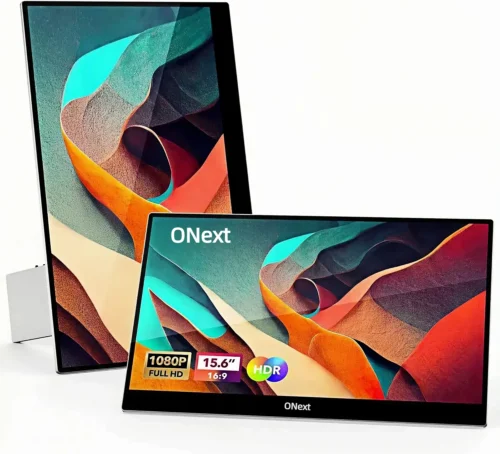 ONext Portable Monitor for Laptop, Slim 15.6 Inch External Monitor with Adjustable kickStand
ONext Portable Monitor for Laptop, Slim 15.6 Inch External Monitor with Adjustable kickStand -
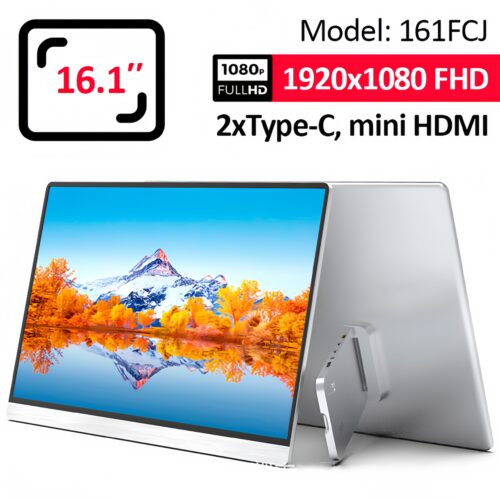 Portable Laptop Screen 16.1 inch Laptop Monitors Full HD, IPS, USB Type-C, Flicker Free, Blue Light Filter Silver With Foldable Stand
Portable Laptop Screen 16.1 inch Laptop Monitors Full HD, IPS, USB Type-C, Flicker Free, Blue Light Filter Silver With Foldable Stand -
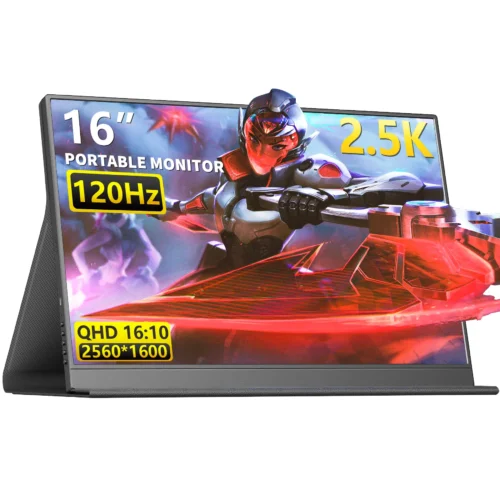 16 Inch Portable Monitor 2560*1600 FullHD 120Hz Gaming Computer Monitor Wide 16:9 Travel Monitors for Laptop Mac Phone Tablet PS4 Switch Xbox Built In Speakers,HDMI/Type-C Monitor
16 Inch Portable Monitor 2560*1600 FullHD 120Hz Gaming Computer Monitor Wide 16:9 Travel Monitors for Laptop Mac Phone Tablet PS4 Switch Xbox Built In Speakers,HDMI/Type-C Monitor -
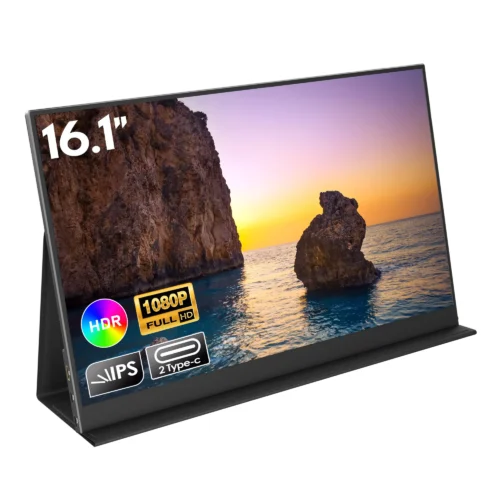 16.1inch 1080P FHD Laptop Monitor USB-C HDMI External Computer Display HDR IPS Gaming Monitor Smart Cover & Speaker, 2nd Screen for Laptop PC Mac Phone Xbox PS3-5 Switch
16.1inch 1080P FHD Laptop Monitor USB-C HDMI External Computer Display HDR IPS Gaming Monitor Smart Cover & Speaker, 2nd Screen for Laptop PC Mac Phone Xbox PS3-5 Switch -
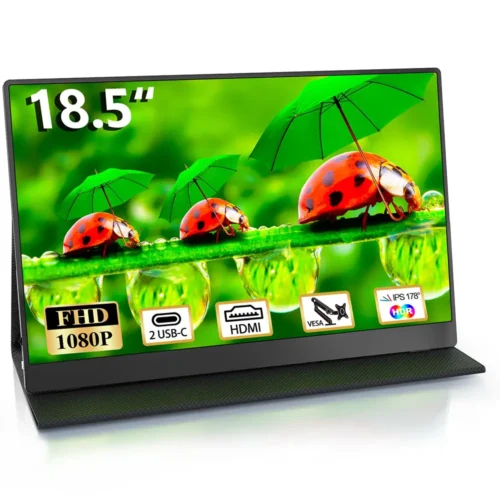 Portable Large Monitor-18.5 Inch Computer Gaming Display 60Hz 100% sRGB FHD 1080P USB-C HDMI IPS Screen for Laptop
Portable Large Monitor-18.5 Inch Computer Gaming Display 60Hz 100% sRGB FHD 1080P USB-C HDMI IPS Screen for Laptop